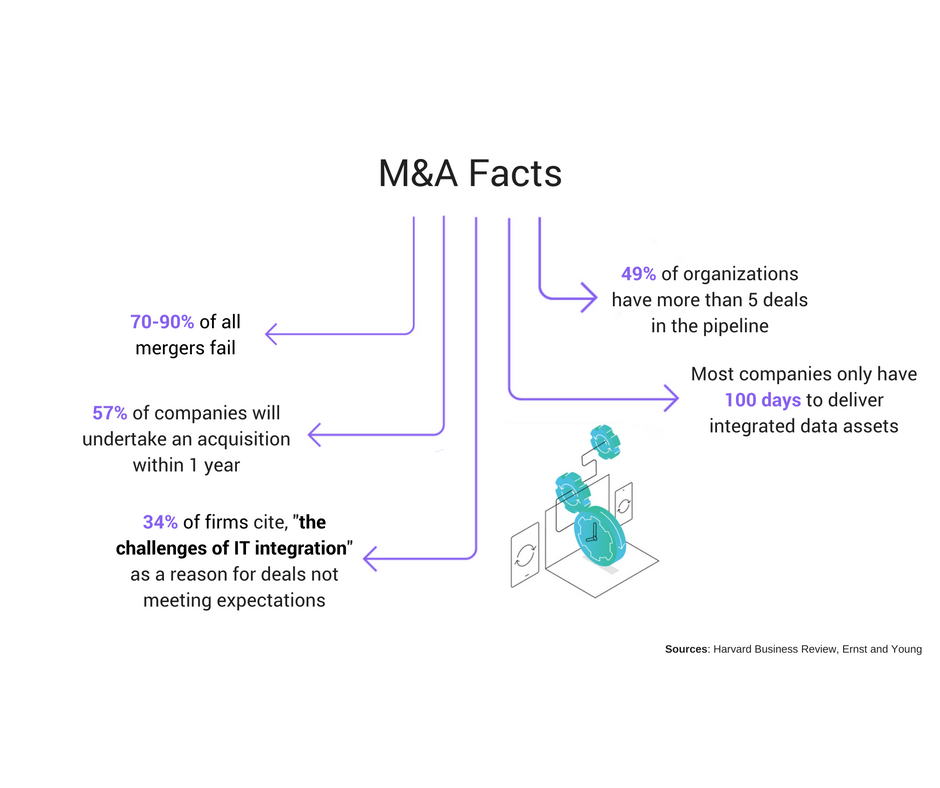Agile M&A: Hit the Ground (with all data) Running on Day One

Integrating data after a merger and acquisition is a formidable task. Find out why you should take data integration into account before the merger, not after.
The Ideal
It’s day one. The merger deal has closed. Operational systems like HR, ERP, CRM and OLTP are up and running with unified data from both companies.
Updated information is being shared across the merged organization, regardless of where it resides—or whether it’s about customers, prospects, payments or products. And the customer experience is preserved and enhanced.
Analytics are plugged into the right data sources for pre- and post-merger reporting. You can monitor performance, uncover new synergies and make the best decisions.
You’re ready to penetrate new markets and cross-sell products.
Sound good? Actually, here’s what usually happens…
The Reality
- Everyday business processes slow down because data is scattered across numerous systems
- LOB teams initiate one-off projects to try and create access to the data they need
- Unsatisfying customer experiences result from inaccurate or duplicate information
- Data integration efforts soak up too much energy and drag on for too long, distracting employees from more essential business initiatives
As a result, sales are lost and the expected business value of the merger is delayed.
Mergers are extremely complex. Integrating business processes, applications and data can be a formidable task. Companies operate many different distributed software systems with disparate data sources, residing on premise and in the cloud. That means more data from more silos.
Deals that Die
Here’s a sobering statistic: Between 70 to 90% of mergers fail, according to Harvard Business Review. In Ernst & Young’s 2016 M&A survey, 34% of respondents cited “underestimating the challenges of IT integration” as one of the most significant issues contributing to deals not meeting expectations.

Deal Making Is an Imperative, Not an Option
Even so, in that same E&Y survey, 57% expect to undertake acquisitions in the next 12 months, and 49% have more than five deals in the pipeline.
Acquisitions are a necessary activity now rather than an occasional event. Companies must maintain leadership products and services. These alliances improve competitive positioning, extend product portfolios and enable entry into new markets or industries.
Creative disruption is the new normal. In this digital world, barriers to competition are coming down, traditional business models are being disrupted, and entire industries are being revolutionized by challenger brands that didn’t exist a few years ago.
Agile companies are shifting their perspective and seeing disruption as an endless source of opportunity to reinvent themselves and seek the innovation necessary to grow.
Act, Not React
With the pace of deals escalating, an already complex IT environment can grow even more complex. And complexity is only going to increase over time as companies adopt new data sources and cloud services.
Integrating data assets is also challenging because of the tight timeframes. Most companies have to deliver tangible results in only 100 days. It’s hard to get money and attention from the business once things are rolling.
Clearly, acquirers must become more agile at data integration.
What Not to Do
Many try to tackle data integration with custom code, requiring experienced developers to create point-to-point integrations between applications and databases. This approach is impractical for businesses with many systems to integrate. Custom code can become brittle, complex and difficult to manage going forward.
On the other hand, data connectivity solutions based on industry standards will work with any system architecture, data source and application. This is the best agile solution for the distributed, hybrid environments involved in M&As.
Proactively Adopt an Agile Approach
Here’s what to look for:
- Full data source coverage: Real-time access to legacy, on premise and cloud data sources across all data types: relational, big data, SaaS and NoSQL
- Instant backend REST API: Access to any data (even behind the firewall) from any mobile or web application
- Pre- and post-merger reporting: Access to any data source from BI/analytics tools
- Standards-based: Technology that adheres to industry standards ensures reliability and compatibility with the acquired company’s systems.
- Data federation: Instantly productive with major data federation technologies, such as Salesforce Connect, Oracle Database Gateway and Microsoft Linked Server
These are the fundamental features that deliver agility and efficiency in M&A, while positioning your merged company to be immediately effective. You can cut integration time, eliminate downtime, improve year-one business decisions and safeguard the customer experience.
Partnering with a supplier that has dedicated expertise in data connectivity eliminates the need for time-consuming custom coding and the need to understand the often arcane details of ever-evolving connectivity standards, as well as numerous APIs, databases and operating systems.
M&A Data Federation Examples
Our data connectivity solutions work easily with leading data federation technologies for an agile data integration strategy:
| Salesforce Connect |
The easiest way to integrate external data with Salesforce is with Salesforce Connect and Progress DataDirect. Your Salesforce applications can access data in real time and connect faster to popular databases like DB2, Oracle, SQL Server, PostgreSQL, Hadoop Hive and Eloqua. |
| Microsoft Linked Server |
Progress DataDirect connectors work out-of-the-box with SQL Server Linked Server to connect external data sources, whether relational, NoSQL, big data or cloud. Popular data sources supported include MongoDB, Apache Cassandra, Salesforce Platform, SAP HANA, Oracle Database, IBM DB2, Oracle Eloqua and Hadoop Hive. |
| Oracle Database Gateway |
Access and integrate non-Oracle data sources such as SQL Server and DB2 quickly and easily during the merger. Progress DataDirect delivers the most scalable, best performing connectivity for Oracle Database Gateway. |
Be Ready—Before the Deal Is Done
Factor data integration into your M&A infrastructure budget so you can plan for connecting the businesses before the merger, not after. Invest in data connectivity so you can build a repeatable data integration model—so next time you can move closer to the ideal.
Beyond the merger, you have a longer term journey, which depends on technologies that support the new company’s future growth, manage changing data sources more elegantly and make it easier to create new data-driven applications. Then you can switch from integration to digital transformation.
Getting data for your application, cloud or platform is what we obsess about at Progress DataDirect. We connect any data source to any application and support you through every step of the process. Try any of our connectors for 30 days absolutely free and begin your digital transformation.
Transform Your Business

Suzanne Rose
Suzanne Rose was previously a senior content strategist and team lead for Progress DataDirect.
